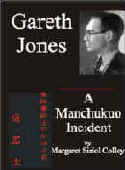Gareth Jones
[bas relief by Oleh Lesiuk]
HOME |
Stop Press |
Complete Soviet Articles & Background Information |
Précis of Gareth's
|
All Published Articles |
BOOKS
|
|
|
|
More Than Grain of Truth(2005) |
|
|
TOPICAL
'Are you Listening NYT?' U.N. Speech - Nov 2009 |
Gareth Recognised at Cambridge - Nov 2009 |
Reporter and the Genocide - Rome, March 2009 |
Order of Freedom Award -Nov 2008 |
Premiere of 'The Living' Documentary Kyiv - Nov 2008 |
Gareth Jones 'Famine' Diaries - Chicago 2008 |
Aberystwyth Memorial Plaque 2006 |
GENERAL
Scholarship Fund |
Site Map |
Links |
Legal Notices |
Sponsored Links |
Contact |
The
Financial News, Wednesday, April 12th, 1933
BALANCE-SHEET
OF THE FIVE-YEAR PLAN
- - - - -
II
- FINANCIAL
IMPRESSIONS
---
By
Gareth Jones
A drastic economy drive is now in progress in the Soviet Union. The control over expenses in the factory is new exceedingly strict. The factories no longer have financial autonomy and a heavy responsibility is placed upon the administration of the factories to balance their budget. Last year the expenses of the factories exceeded the estimates. To counteract the deficits, which were caused by over spending the planned figures imposed from above on the factory administrations are now to be absolutely obligatory, and the financial work of each factory is to be controlled each month by the bank, which gives it credit.
When a factory or a trust has a deficit, sanctions are applied. In some cases, where the deficit is attributed to bad organisation a trial of the director is held and he is condemned and thrown out of the Communist. Part. Other sanctions in cases of deficit are: Non-payment of salaries and the obligation for the factory administration to dismiss a part of the staff. The rigid economy drive has thus been responsible for a part of the growing unemployment. In some offices and factories 20 per cent, 30 per cent., and even 40 per cent of the staff have been dismissed on financial grounds.
No
Figures
The absence of statistics upon the most vital sections of financial life makes it difficult to form a judgment concerning the currency. Gold reserve figures are no longer published. Gold production figures are hard to obtain, but in one official organisation the figure given for 1932 was 84,000,100 roubles. No figures are published on the amount of gold obtained from the Torgsin Stores, where customers have been able to buy with gold, silver, or with foreign currency. Even on the issue of roubles there have been no statistics published since September 5th, 1932. Some reliable observers state that they have seen at least l00 one-rouble notes with the same number printed upon them. The impression one obtains, is that those in charge of Soviet finances are bewildered.
There is only one certainly about. Soviet finances, and that is that there is a large-scale inflation, however loudly it may be denied by the Soviet Government, and however much members of the Communist Party may boast that “the chervonetz is the only stable currency in the world.” Some data on prices form sufficient proof of this. The Government has opened the so-called commercial shops for those who earn good salaries, where the following prices are now normal:
Butter: From 62 roubles to 75 roubles a kilo. (rouble at par equals 3s.).
Meat: 15 roubles a kilo.
Sugar: 15 roubles a kilo., but difficult to obtain.
Bread (black): 3 roubles a kilo.
(white): 4 roubles 50 kopeks a kilo.
In
the open market the prices are as follows:-
Meat: About 20 roubles a kilo.
Tea: 25 roubles a pound.
Butter (when obtainable): 65 roubles a kilo.
In the Ukraine, where the food shortage is greater, the prices are higher. In the co-operatives bread may be obtained cheaply for breadcards at the price of 7 kopeks a pound for black bread and 12 kopeks a pound for so-called white bread.
The
gold prices in the Soviet Union provide interesting data for the economist:-
Flour (25 per cent.): 47 kopeks a kilo.
Sugar (refined): 50 kopeks a kilo.
Potato flour: 40 kopeks a kilo.
Flour (85 per cent.): 24 kopeks a kilo.
Butter in Torgsin (gold or foreign currency) costs from 1 r. 40k. to 1 r. 90k.
Rising Prices
The rapid rise in prices has been a source of disorder for the Plan, for long-term planning ahead is disarranged when the currency loses its value, in the same way as in the capitalist world falling prices disorganise trade. The high prices in the Soviet Union must, however, be studied in connection with the wages which are paid. An unskilled labourer receives about 120 roubles a month; a skilled worker may receive anything from 200 to 600 roubles. Engineers are well paid, and usually receive monthly from about 500 to 1,500 roubles, and even 2,000 roubles. A young train conductor receives about 67 roubles a month.
A part of the wages goes, however, to the loans and lotteries, which play an important part in financing the Plan. In 1932 15.9 per cent. of the budgetary receipts came from loans. In 1933 it is planned to raise 2,800,000,000 roubles through internal loans. Lotteries, while providing a negligible part of the State funds compared with the loans, are used to finance such undertakings as the Soviet Mercantile Marine, the Society for Aviation and Chemical Defence, and the Motorisation of the Soviet Union. Prizes, such as motor-cars, which may be owned as private property by one man, and even money prizes, are offered as incentives to invest in these lotteries.
In internal finances one obtains impression of disorder. The rouble seems to have run away from the Plan. On the Black Market 50 to 70 roubles can be obtained for a dollar, instead of the legal 1 rouble 94 kopeks. Any suggestion of devaluation, however, is immediately refuted with indignation.
Obligations Abroad
The external financial situation also arouses no confidence. It is
estimated that the Soviet Union’s obligations abroad total £120,000,000.
Recently the adverse balance has mounted up with the declining prices of the
goods exported by Russia. In 1929 the Soviet Union exported 923,700,000
gold roubles’ worth of goods, whereas in 1932 her exports amounted to
563,900,000 gold roubles. Her imports have not declined so rapidly, having
fallen from 880,600,000 gold roubles in 1929 to 698,700,000 gold roubles in
1932.
World prices have declined so much and Russia’s agriculture has received such a blow from the Five-Year Plan, that it is doubtful whether the Soviet Union will long be able to maintain her payments abroad, however meticulous she may have been in meeting payments up to now. If an embargo is placed upon Soviet imports by the British Government, the difficulties of payment will become still greater, for normally nearly 30 per cent. of Soviet Russia’s exports are destined for Great Britain, and a blow will be dealt to the creditors of the Soviet Union in Britain, and especially in Germany, where the Government has guaranteed German exports to Russia to a considerable degree.
The concluding article of this series, dealing with agriculture, will appear tomorrow. The first, on unemployment, appeared in our issue of yesterday.
|
|
|
|



